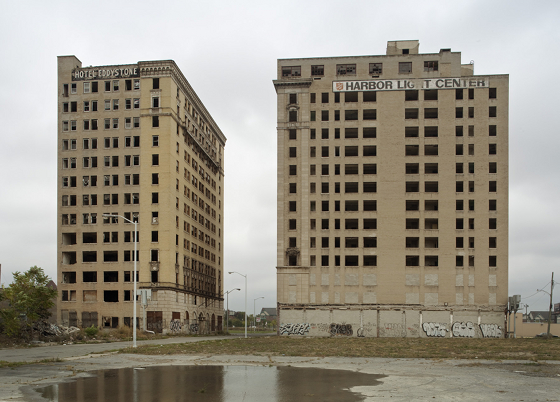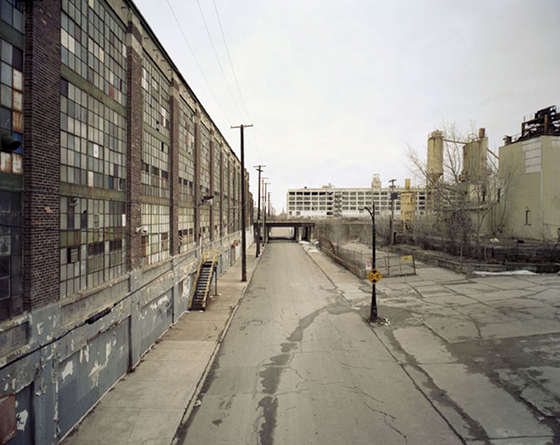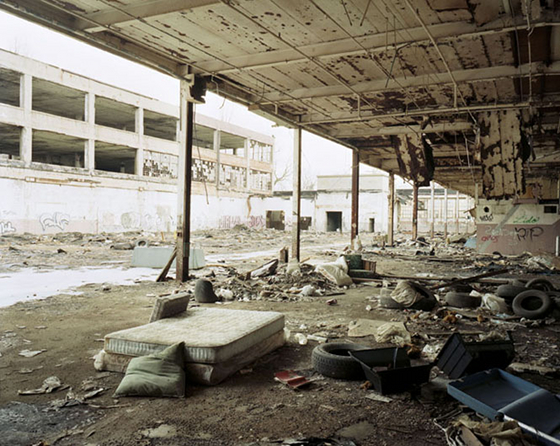The Presence of Absence: Detroit's haunting architectural relics
Texto por Simon Keane-Cowell
Zürich, Suiza
03.09.10
There's faded grandeur. And then there's Detroit. Once the fourth-largest city in the US, its spectacular economic and social decline is writ large in the disintegration of its architectural fabric. With its former manufacturing industries decimated and parts of downtown Detroit becoming a depopulated wasteland, leading American photographer Sean Hemmerle has created 'Rust Belt' a series of compelling images – at times poetic, at others unnverving – of the city's former urban glory, both industrial and residential. His striking work serves as both architectural record and effective social commentary.
There's faded grandeur. And then there's Detroit. Once the fourth-largest city in the US, its spectacular economic and social decline is writ large in the disintegration of its architectural fabric. With its former manufacturing industries decimated and parts of downtown Detroit becoming a depopulated wasteland, leading American photographer Sean Hemmerle has created 'Rust Belt' a series of compelling images – at times poetic, at others unnerving – of the city's former urban glory, both industrial and residential. His striking work serves as both architectural record and effective social commentary.
.....
Main Lobby, Michigan Central Station, Detroit. Designed by firms Warren & Wetmore and Reed & Stern, who also designed New York's Grand Central Station, and completed in 1913, the building was abandoned in 1988; photo Sean Hemmerle, March 2008

Main Lobby, Michigan Central Station, Detroit. Designed by firms Warren & Wetmore and Reed & Stern, who also designed New York's Grand Central Station, and completed in 1913, the building was abandoned in 1988; photo Sean Hemmerle, March 2008
×Michigan Central Station, Detroit, completed in 1913 and decommissioned in 1988. In spite of its dilapidated state, its grand Beaux-Arts architecture has, fortunately, saved it from demolition; photo Sean Hemmerle

Michigan Central Station, Detroit, completed in 1913 and decommissioned in 1988. In spite of its dilapidated state, its grand Beaux-Arts architecture has, fortunately, saved it from demolition; photo Sean Hemmerle
×Exterior of Main Lobby, Michigan Central Station, Detroit; photo Sean Hemmerle, March 2008
The last train pulled out of Michigan Central Station in 1988. Since then, the building has been unoccupied; photo Sean Hemmerle

The last train pulled out of Michigan Central Station in 1988. Since then, the building has been unoccupied; photo Sean Hemmerle
×The Fisher Body Plant #21, Detroit. The building was originally constructed to produce bodies for Buick and Cadillac and was abandoned in 1991; photo Sean Hemmerle, March 2008

The Fisher Body Plant #21, Detroit. The building was originally constructed to produce bodies for Buick and Cadillac and was abandoned in 1991; photo Sean Hemmerle, March 2008
×Inside the Fisher Body Plant #21, Detroit. 'Ziggurat 2007–2008' installation, which consists of found wood brick tiles from the space, by artist Scott Hocking; photo Sean Hemmerle, March 2008

Inside the Fisher Body Plant #21, Detroit. 'Ziggurat 2007–2008' installation, which consists of found wood brick tiles from the space, by artist Scott Hocking; photo Sean Hemmerle, March 2008
×The Fisher Body Plant #21, Detroit. Completed in 1921 for the production of Buick and Cadillac bodies, the building was decommissioned 70 years later; photo Sean Hemmerle, March 2008

The Fisher Body Plant #21, Detroit. Completed in 1921 for the production of Buick and Cadillac bodies, the building was decommissioned 70 years later; photo Sean Hemmerle, March 2008
×Hastings Street, Detroit; photo Sean Hemmerle, March 2008
Interior of Detroit's Michigan Theater. The structure was completed in 1926 by Chicago-based architects Rapp & Rapp. It functioned as a performance space until 1976, when it was converted into a parking garage; photo Sean Hemmerle

Interior of Detroit's Michigan Theater. The structure was completed in 1926 by Chicago-based architects Rapp & Rapp. It functioned as a performance space until 1976, when it was converted into a parking garage; photo Sean Hemmerle
×Detroit's former Packard Automobile Manufacturing Plant; photo Sean Hemmerle, March 2008
Former housing plots in downtown Detroit; photo Sean Hemmerle, March 2008
Examples of Detroit's Victorian housing stock, now abandoned; photo Sean Hemmerle, September 2009
One of many Detroit's 19th-century private houses, now in danger of demolition; photo Sean Hemmerle

One of many Detroit's 19th-century private houses, now in danger of demolition; photo Sean Hemmerle
×Downtown's Brush Park neighbourhood, where the fate of a large number of Victorian houses hangs in the balance; photo Sean Hemmerle

Downtown's Brush Park neighbourhood, where the fate of a large number of Victorian houses hangs in the balance; photo Sean Hemmerle
×The intersection of Helen and Georgia Streets, Detroit. The demolition of once middle-class homes has created a new urban wasteland; photo Sean Hemmerle

The intersection of Helen and Georgia Streets, Detroit. The demolition of once middle-class homes has created a new urban wasteland; photo Sean Hemmerle
×The auditorium at Jane Cooper Elementary School, which has been stripped of almost all its metal, leaving only the wooden seats and backs; photo Sean Hemmerle

The auditorium at Jane Cooper Elementary School, which has been stripped of almost all its metal, leaving only the wooden seats and backs; photo Sean Hemmerle
×Not even two years closed, the Jane Cooper Elementary School has been looted of all its scrappable metal and has had its windows broken or removed, while classroom materials are left to decay; photo Sean Hemmerle

Not even two years closed, the Jane Cooper Elementary School has been looted of all its scrappable metal and has had its windows broken or removed, while classroom materials are left to decay; photo Sean Hemmerle
×Designed by Albert Kahn for the Murray Manufacturing Company and completed in 1925, the Russell Industrial Center, Detroit, has been used to manufacture car parts and ammunitions, and now is home to a number of artists; photo Sean Hemmerle, February 2009

Designed by Albert Kahn for the Murray Manufacturing Company and completed in 1925, the Russell Industrial Center, Detroit, has been used to manufacture car parts and ammunitions, and now is home to a number of artists; photo Sean Hemmerle, February 2009
×Detroit's 14-storey Lafayette Building, completed in 1924, became one of downtown's most desirable addresses by the 1930s. It was demolished in February 2010; photo Sean Hemmerle

Detroit's 14-storey Lafayette Building, completed in 1924, became one of downtown's most desirable addresses by the 1930s. It was demolished in February 2010; photo Sean Hemmerle
×Hotels Eddystone and Park Avenue, both designed by Louis Kamper. 2006 saw the structures added to the National Historical Register; photo Sean Hemmerle

Hotels Eddystone and Park Avenue, both designed by Louis Kamper. 2006 saw the structures added to the National Historical Register; photo Sean Hemmerle
×View of downtown Detroit through a window at Hotel Eddystone, one of Louis Kamper's three hotels on Park Avenue and one of the city's former main destinations; photo Sean Hemmerle

View of downtown Detroit through a window at Hotel Eddystone, one of Louis Kamper's three hotels on Park Avenue and one of the city's former main destinations; photo Sean Hemmerle
×.....

























